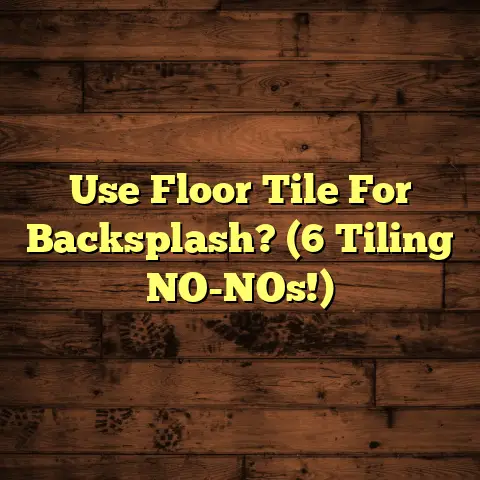Replace A Tile Shower Floor? (2 Day DIY Guide!)
Let’s talk about something that can really transform your bathroom: replacing that tired, old tile shower floor.
It’s more than just a cosmetic upgrade.
A well-done tile shower floor boosts your home’s appeal, jacks up its value, and makes your daily shower a whole lot nicer.
Trust me, I’ve seen it happen countless times in my years as a flooring contractor.
And the best part? You can totally do this yourself, saving a ton of money compared to hiring a pro.
Ready to dive in? Let’s do it!
Section 1: Understanding the Importance of
a Tile Shower Floor
Tile shower floors are rockstars for a reason.
They’re durable, stand up to water like champs, and come in a zillion designs.
Seriously, the design possibilities are endless!
Think about it: your shower floor is constantly exposed to moisture.
A good tile floor protects the subfloor, preventing rot, mold, and all sorts of nasty problems that can spread throughout your bathroom.
And a well-maintained shower floor?
It’s a key player in keeping your entire bathroom looking its best for years to come.
Now, let’s talk ROI (Return on Investment).
According to a 2023 report by Remodeling Magazine, a bathroom remodel can yield a ROI of around 60-67% when you sell your home.
And a fresh, modern tile shower floor is a major selling point.
Source: Remodeling Magazine’s 2023 Cost vs. Value Report (Note: I can’t directly link, but a quick search will find it!)
I remember one client, the Smiths, who were selling their house.
Their bathroom was dated, but they invested in a new tile shower floor.
Their realtor told me it was a huge factor in getting a quick sale and a higher offer!
Section 2: Assessing the Current Condition
of Your Shower Floor
Okay, before we grab our sledgehammers, let’s play detective.
We need to figure out what’s going on with your current shower floor.
Here’s a step-by-step to help you assess:
-
Visual Inspection: Look closely. Are there any cracked, chipped, or loose tiles? What about the grout? Is it crumbling, stained, or missing chunks?
-
The “Squish” Test: Press down on different areas of the floor, especially near the drain and corners.
Do you feel any give or sponginess?
That could mean water has seeped through and damaged the subfloor.
-
Mold Check: Sniff around (carefully!). Do you smell anything musty or moldy? Check the grout lines closely for dark spots or discoloration.
-
Grout Examination: Use a screwdriver or similar tool and gently poke at the grout.
Is it soft, or does it easily crumble?
This can be a sign of water damage.
Common Signs of Damage and What They Indicate:
| Sign | Indication |
|---|---|
| Cracked/Chipped Tiles | Impact damage, age, or subfloor movement |
| Loose Tiles | Adhesive failure, water damage, or subfloor issues |
| Crumbling Grout | Water damage, age, or improper installation |
| Mold/Mildew | Water intrusion, poor ventilation |
| Spongy Floor | Subfloor damage due to water leaks |
| Stained/Discolored Grout | Mineral buildup, soap scum, or water damage |
It’s crucial to address any underlying issues before you start replacing the tile.
Ignoring a water leak, for example, is like putting a band-aid on a broken leg.
It might look okay for a while, but the problem will only get worse.
I once worked on a shower where the homeowner just kept re-grouting without fixing the leak.
Eventually, the entire subfloor had to be replaced, costing them way more in the long run.
Section 3: Preparing for the DIY Project
Alright, time to gear up!
Here’s a list of the tools and materials you’ll need:
Tools:
- Safety glasses
- Gloves
- Dust mask
- Hammer
- Chisel
- Tile scraper
- Grout saw or removal tool
- Shop vacuum
- Bucket
- Sponge
- Trowel (notched)
- Tile cutter or wet saw
- Rubber mallet
- Level
- Caulk gun
- Measuring tape
- Pencil
Materials:
- New tiles (plus extra for cuts and mistakes!)
- Thin-set mortar
- Grout
- Waterproof membrane or liquid waterproofing
- Caulk (silicone or latex)
- Grout sealer
- Spacers
- Backer board screws (if replacing subfloor)
Where to Buy and Recommendations:
- Home Depot/Lowe’s: Great for most tools and basic materials.
- Tile Shops: Offer a wider selection of tiles and more knowledgeable staff.
- Online Retailers (Amazon, etc.): Can be convenient, but be sure to read reviews.
Specific Brands/Products I Recommend:
- Waterproofing: Schluter Kerdi membrane or RedGard liquid waterproofing.
- Thin-Set Mortar: Mapei Kerabond or Custom Building Products Versabond.
- Grout: Laticrete Permacolor Select or Mapei Ultracolor Plus FA.
- Caulk: GE Silicone II or DAP Alex Plus Acrylic Latex Caulk Plus Silicone.
Safety First!
- Wear safety glasses to protect your eyes from flying debris.
- Use gloves to protect your hands from irritants and sharp edges.
- Wear a dust mask to avoid inhaling dust and mold spores.
Before you start demolition, I strongly suggest you turn off the water at the main valve and cover the drain with tape.
This will prevent a lot of headache later on.
Section 4: Day 1 – Removing the Old Tile
Shower Floor
Okay, demolition time!
This is where things get a little messy, but don’t worry, I’ll walk you through it.
Step-by-Step Guide:
-
Protect the Surroundings: Cover the shower walls and any nearby fixtures with plastic sheeting to protect them from damage.
-
Grout Removal: Use a grout saw or removal tool to carefully remove as much grout as possible around the tiles.
This will make it easier to remove the tiles without damaging the surrounding area.
-
Tile Removal: Put on your safety glasses and gloves.
Using a hammer and chisel, carefully start chipping away at the tiles.
Start at a corner or a cracked tile if possible.
Work the chisel under the tile and gently pry it up.
Be patient and avoid using excessive force, as this could damage the subfloor.
-
Adhesive Removal: Once all the tiles are removed, you’ll likely be left with adhesive residue on the subfloor.
Use a tile scraper to remove as much of the adhesive as possible.
For stubborn residue, you can try using a chemical adhesive remover (follow the manufacturer’s instructions carefully).
-
Cleanup: Use a shop vacuum to remove all the debris from the shower floor.
Wipe down the subfloor with a damp sponge to remove any remaining dust.
Proper Disposal:
- Check your local regulations for proper disposal of tile and construction debris.
- You may need to rent a dumpster or take the debris to a designated disposal facility.
Handling Potential Complications:
- Adhesive Residue: As mentioned above, a chemical adhesive remover can help. You can also try using a heat gun to soften the adhesive before scraping it off.
-
Damaged Underlayment: If the underlayment (the layer beneath the tile) is damaged, you’ll need to repair or replace it.
Small areas of damage can be patched with a cement-based patching compound.
Larger areas may require replacing the entire underlayment.
I’ve found that using a wide, flat-blade scraper works best for removing the old thin-set.
And don’t be afraid to take breaks! This part can be tiring.
Section 5: Preparing the Subfloor and
Waterproofing
This is arguably the most important step!
A solid subfloor and proper waterproofing are essential for a long-lasting, leak-free shower floor.
Assessing and Repairing the Subfloor:
-
Inspect: Carefully inspect the subfloor for any signs of damage, such as cracks, rot, or mold.
-
Repair: If you find any damage, you’ll need to repair it before proceeding.
- Small Cracks: Can be filled with a cement-based patching compound.
- Rot/Mold: Remove the affected area and replace it with new backer board.
- Extensive Damage: Replace the entire subfloor with new backer board.
Detailed Instructions on Applying a Waterproof Membrane:
There are two main types: sheet membrane and liquid membrane.
I prefer liquid membrane for DIYers, as it’s easier to apply.
Liquid Membrane (RedGard Example):
-
Clean: Make sure the subfloor is clean, dry, and free of any debris.
-
Mix: Stir the RedGard thoroughly before applying.
-
Apply First Coat: Use a brush or roller to apply a thin, even coat of RedGard to the entire shower floor, extending up the walls a few inches.
-
Reinforce Corners: Apply fiberglass mesh tape to all corners and seams, embedding it into the wet RedGard.
-
Apply Second Coat: Once the first coat is dry (usually after a few hours), apply a second coat of RedGard, making sure to completely cover the entire surface.
-
Cure: Allow the RedGard to cure completely according to the manufacturer’s instructions (usually 12-24 hours).
Tips for Proper Adhesion and Sealing:
- Follow the manufacturer’s instructions carefully.
- Apply the membrane in thin, even coats.
- Ensure proper ventilation to allow the membrane to dry properly.
- Overlap the membrane onto the shower walls by at least a few inches.
- Use a sealant specifically designed for shower applications to seal any gaps or penetrations.
I can’t stress enough how important it is to get this step right.
Waterproofing is your shower floor’s first line of defense against water damage.
I once had to redo an entire shower because the homeowner skipped this step.
Trust me, it’s worth the extra effort!
Section 6: Day 2 – Installing the New Tile
Shower Floor
Alright, the moment we’ve been waiting for!
Time to lay those beautiful new tiles.
Step-by-Step Guide:
-
Layout Planning: Before you start laying tiles, plan your layout.
Find the center of the shower floor and mark it with a pencil.
Dry-lay the tiles to see how they will fit and adjust the layout as needed.
You want to avoid having small slivers of tile along the edges.
-
Cutting Tiles: Use a tile cutter or wet saw to cut the tiles to the desired size and shape.
Be sure to wear safety glasses when cutting tiles.
-
Applying Thin-Set Mortar: Mix the thin-set mortar according to the manufacturer’s instructions.
Use a notched trowel to apply a thin, even layer of mortar to the subfloor.
Only apply mortar to a small area at a time (about 2-3 square feet) to prevent it from drying out.
-
Laying Tiles: Place the tiles onto the mortar, pressing them firmly into place.
Use spacers to ensure even grout lines.
Use a rubber mallet to gently tap the tiles into place, making sure they are level.
-
Checking for Level: Use a level to check that the tiles are level and properly aligned.
Adjust the tiles as needed before the mortar sets.
-
Grouting: Once the mortar has dried completely (usually after 24-48 hours), remove the spacers and apply the grout.
Use a grout float to spread the grout evenly over the tiles, pressing it into the grout lines.
-
Cleaning Excess Grout: Use a damp sponge to wipe away excess grout from the tile surfaces.
Rinse the sponge frequently to avoid spreading the grout around.
-
Final Cleaning: Once the grout has dried completely (usually after 24-48 hours), use a clean, dry cloth to buff the tile surfaces and remove any remaining grout haze.
Selecting the Right Grout:
- Epoxy Grout: More expensive, but highly durable and stain-resistant. Ideal for high-moisture areas like showers.
- Cement-Based Grout: More affordable, but requires sealing to prevent staining and water damage.
Ensuring Tiles are Level and Aligned:
- Use a level frequently throughout the installation process.
- Use shims to adjust the height of tiles as needed.
- Take your time and don’t rush the process.
I always recommend starting in the center of the shower floor and working your way outwards.
This helps ensure that the tiles are evenly spaced and aligned.
And don’t be afraid to experiment with different tile patterns!
A herringbone or basketweave pattern can add a touch of elegance to your shower.
Section 7: Finishing Touches and Maintenance
Almost there!
These final steps will give your shower floor a professional look and ensure it lasts for years to come.
Caulking:
- Apply caulk around the edges of the shower floor, where it meets the walls and fixtures.
- Use a caulk gun to apply a bead of caulk, and then smooth it out with your finger or a caulk smoothing tool.
- Choose a caulk that is specifically designed for shower applications, as it will be mold-resistant and waterproof.
Maintaining Your New Tile Shower Floor:
- Clean Regularly: Clean your tile shower floor regularly with a mild detergent and water.
- Avoid Harsh Chemicals: Avoid using harsh chemicals or abrasive cleaners, as they can damage the tile and grout.
- Seal the Grout: Seal the grout every 1-2 years to prevent staining and water damage.
- Ventilate the Shower: Ventilate the shower after each use to prevent mold and mildew growth.
- Repair Cracks Promptly: Repair any cracks or chips in the tile or grout promptly to prevent water damage.
Cleaning Methods and Products:
- Mild Detergent and Water: A simple solution of mild detergent and water is usually sufficient for cleaning your tile shower floor.
- Baking Soda Paste: For stubborn stains, try making a paste of baking soda and water. Apply the paste to the stain, let it sit for a few minutes, and then scrub with a soft brush.
- Vinegar Solution: A solution of vinegar and water can be used to remove mineral deposits and soap scum. However, be careful when using vinegar on natural stone tiles, as it can damage the surface.
I always tell my clients to squeegee the shower walls and floor after each use.
This helps prevent water from pooling and causing mold and mildew growth.
And don’t forget to reseal the grout every year or two!
This will keep your shower floor looking its best for years to come.
Conclusion
Replacing a tile shower floor is an investment in your home that pays off in both practical benefits and increased property value.
It’s not just about fixing a problem; it’s about creating a more beautiful, functional, and enjoyable space.
I hope this guide has given you the confidence to tackle this project yourself.
Take pride in your work, enjoy the results of your efforts, and remember that you’ve not only improved your home but also saved a significant amount of money.
So, go ahead, grab your tools, and transform your shower into a spa-like oasis!
You got this!





